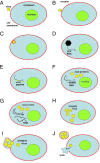Shedding light on virus replication
- PMID: 18997007
- PMCID: PMC2582277
- DOI: 10.1073/pnas.0809841105
Shedding light on virus replication
Conflict of interest statement
The author declares no conflict of interest.
Figures


Comment on
-
Visualizing the dynamics of viral replication in living cells via Tat peptide delivery of nuclease-resistant molecular beacons.Proc Natl Acad Sci U S A. 2008 Nov 11;105(45):17522-5. doi: 10.1073/pnas.0807066105. Epub 2008 Nov 6. Proc Natl Acad Sci U S A. 2008. PMID: 18988730 Free PMC article.
Similar articles
-
Visualizing the dynamics of viral replication in living cells via Tat peptide delivery of nuclease-resistant molecular beacons.Proc Natl Acad Sci U S A. 2008 Nov 11;105(45):17522-5. doi: 10.1073/pnas.0807066105. Epub 2008 Nov 6. Proc Natl Acad Sci U S A. 2008. PMID: 18988730 Free PMC article.
-
Visualization and detection of infectious coxsackievirus replication using a combined cell culture-molecular beacon assay.Appl Environ Microbiol. 2005 Dec;71(12):8397-401. doi: 10.1128/AEM.71.12.8397-8401.2005. Appl Environ Microbiol. 2005. PMID: 16332827 Free PMC article.
-
Molecular beacon-quantum dot-Au nanoparticle hybrid nanoprobes for visualizing virus replication in living cells.Chem Commun (Camb). 2010 Jun 14;46(22):3914-6. doi: 10.1039/c001553a. Epub 2010 Apr 23. Chem Commun (Camb). 2010. PMID: 20419176
-
Chapter 3. Replication of the hepatitis delta virus RNA genome.Adv Virus Res. 2009;74:103-21. doi: 10.1016/S0065-3527(09)74003-5. Adv Virus Res. 2009. PMID: 19698896 Review.
-
Preferential coxsackievirus replication in proliferating/activated cells: implications for virus tropism, persistence, and pathogenesis.Curr Top Microbiol Immunol. 2008;323:149-73. doi: 10.1007/978-3-540-75546-3_7. Curr Top Microbiol Immunol. 2008. PMID: 18357769 Review.
References
-
- Cliver DO. In: Foodborne Diseases. Cliver DO, editor. San Diego: Academic; 1990. pp. 275–292.
-
- Tyagi S, Kramer FR. Molecular beacons: Probes that fluoresce upon hybridization. Nat Biotechnol. 1996;14:303–308. - PubMed
Publication types
MeSH terms
Substances
LinkOut - more resources
Full Text Sources

